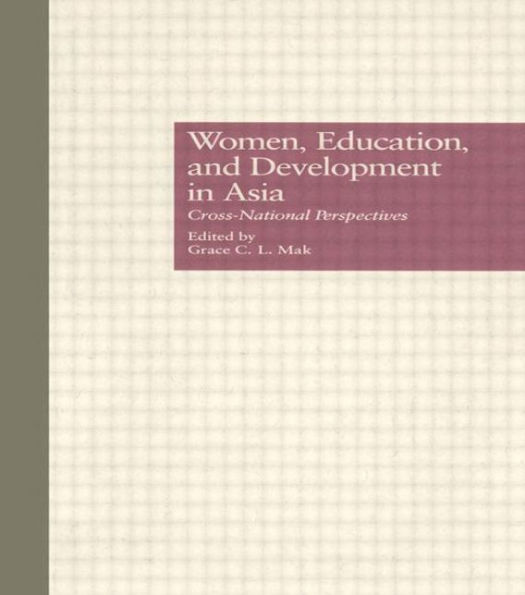Women, Education, and Development in Asia: Cross-National Perspectives
This volume of twelve original essays examines the interplay between women's education and development, and if and how it has changed women's status, in selected nations in Asia.
Educational expansion in recent decades have benefitted women in Asia at least in quantitative terms. Industrialization has also created room for increased waged employment for them. However, the relative openness of these systems has not been paralleled at the cultural level. Women in Asia, which remains largely patriarchal, are thus caught in contradictions. This volume examines how women use and compromise with opportunities and limits in education, the role of education in their economic participation, and the enhancement and tension brought to their family roles.
The volume is edited from a cross-national perspective. The chapters, each covering a nation, rest on a common framework. Each begins with a brief historical account of education fore women. It then investigates the extent women have been able to take advantage of them. What follows is an analysis of how women use their education in the labor market and in the family. Society's definition of women's roles in the family often acts to reduce the effect of schooling on women's economic participation. This interplay is further complicated by such factors as social class and/or caste, religion and ethnicity.
1128401289
Educational expansion in recent decades have benefitted women in Asia at least in quantitative terms. Industrialization has also created room for increased waged employment for them. However, the relative openness of these systems has not been paralleled at the cultural level. Women in Asia, which remains largely patriarchal, are thus caught in contradictions. This volume examines how women use and compromise with opportunities and limits in education, the role of education in their economic participation, and the enhancement and tension brought to their family roles.
The volume is edited from a cross-national perspective. The chapters, each covering a nation, rest on a common framework. Each begins with a brief historical account of education fore women. It then investigates the extent women have been able to take advantage of them. What follows is an analysis of how women use their education in the labor market and in the family. Society's definition of women's roles in the family often acts to reduce the effect of schooling on women's economic participation. This interplay is further complicated by such factors as social class and/or caste, religion and ethnicity.
Women, Education, and Development in Asia: Cross-National Perspectives
This volume of twelve original essays examines the interplay between women's education and development, and if and how it has changed women's status, in selected nations in Asia.
Educational expansion in recent decades have benefitted women in Asia at least in quantitative terms. Industrialization has also created room for increased waged employment for them. However, the relative openness of these systems has not been paralleled at the cultural level. Women in Asia, which remains largely patriarchal, are thus caught in contradictions. This volume examines how women use and compromise with opportunities and limits in education, the role of education in their economic participation, and the enhancement and tension brought to their family roles.
The volume is edited from a cross-national perspective. The chapters, each covering a nation, rest on a common framework. Each begins with a brief historical account of education fore women. It then investigates the extent women have been able to take advantage of them. What follows is an analysis of how women use their education in the labor market and in the family. Society's definition of women's roles in the family often acts to reduce the effect of schooling on women's economic participation. This interplay is further complicated by such factors as social class and/or caste, religion and ethnicity.
Educational expansion in recent decades have benefitted women in Asia at least in quantitative terms. Industrialization has also created room for increased waged employment for them. However, the relative openness of these systems has not been paralleled at the cultural level. Women in Asia, which remains largely patriarchal, are thus caught in contradictions. This volume examines how women use and compromise with opportunities and limits in education, the role of education in their economic participation, and the enhancement and tension brought to their family roles.
The volume is edited from a cross-national perspective. The chapters, each covering a nation, rest on a common framework. Each begins with a brief historical account of education fore women. It then investigates the extent women have been able to take advantage of them. What follows is an analysis of how women use their education in the labor market and in the family. Society's definition of women's roles in the family often acts to reduce the effect of schooling on women's economic participation. This interplay is further complicated by such factors as social class and/or caste, religion and ethnicity.
125.0
In Stock
5
1

Women, Education, and Development in Asia: Cross-National Perspectives
286
Women, Education, and Development in Asia: Cross-National Perspectives
286
125.0
In Stock

Product Details
| ISBN-13: | 9780815307952 |
|---|---|
| Publisher: | Taylor & Francis |
| Publication date: | 10/01/1996 |
| Series: | Reference Books In International Education , #82 |
| Pages: | 286 |
| Product dimensions: | 5.44(w) x 8.50(h) x (d) |
From the B&N Reads Blog
